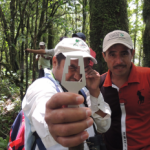 The wisdom of disparate crowds in relation to supposed experts is a pretty well known thesis, with James Surowiecki’s 2004 book bringing it to widespread attention. The thesis has been built upon recently by thinkers such as Noreena Hertz in her latest book Eyes Wide Open.
The wisdom of disparate crowds in relation to supposed experts is a pretty well known thesis, with James Surowiecki’s 2004 book bringing it to widespread attention. The thesis has been built upon recently by thinkers such as Noreena Hertz in her latest book Eyes Wide Open.
A nice example of the thesis in action has come from a recent study into the measurement of carbon dioxide trapped in forests. The work, conducted by the Nairobi-based World Agroforestry Centre (ICRAF), found that local communities were more effective at producing carbon data than experts with high tech equipment. Yet, despite this, nearly 50% of REDD+ (Reducing Emissions from Deforestation and Forest Degradation) projects, whose credibility rests on the accurate measurement of carbon capture in forests, fail to engage with these local communities in data gathering. This is despite assertions by the UN that such projects should do all they can to engage local communities.
The authors of the paper—the first-ever quantitative study of REDD+ community participation—argue that locally-gathered data is not only accurate but also more legitimate and cost-effective in the long run. It also improves trust in REDD+ among local communities.
“Saving the world’s forests requires us to close the massive gulf between international promises and realities on the ground,” said Finn Danielsen, the study’s lead author and senior ecologist at the Nordic Foundation for Environment and Development in Copenhagen, Denmark. “Our research shows that if more REDD+ projects were to include community monitoring, we would see a more just global effort to fight climate change that meaningfully incorporates insight from people who depend on forests for everything from their incomes to their food—and are eager to protect these precious natural resources as a result.”
To test the effectiveness of local communities, the researchers trained community members in simple measuring tactics before sending them off to measure 289 pre-selected forest plots. They were asked to record things such as the number of trees, their girth and biomass per hectare. Researchers then compared their measurements to those gathered by professional foresters using handheld computers.
The results showed strikingly similar results between community members and professional foresters across countries and forest types. This corroborates a small but growing body of research suggesting that, when armed with the simplest of techniques and equipment, community members with limited education can accurately monitor forest biomass—previously thought to be the domain of highly-trained professionals.
The researchers also compared the financial costs of community monitoring, discovering that whilst the initial training costs meant in the short-term, community teams were more expensive than experts, in the longer-term, the community led approach was indeed cheaper.
“We’re convinced that engaging communities is ultimately the most cost-effective approach. The small extra cost would be largely offset by its benefits to both local people—who would earn wages and gain training from these activities—and larger global efforts to address climate change,” said Subekti Rahayu, an analyst at ICRAF who conducted fieldwork for the study.